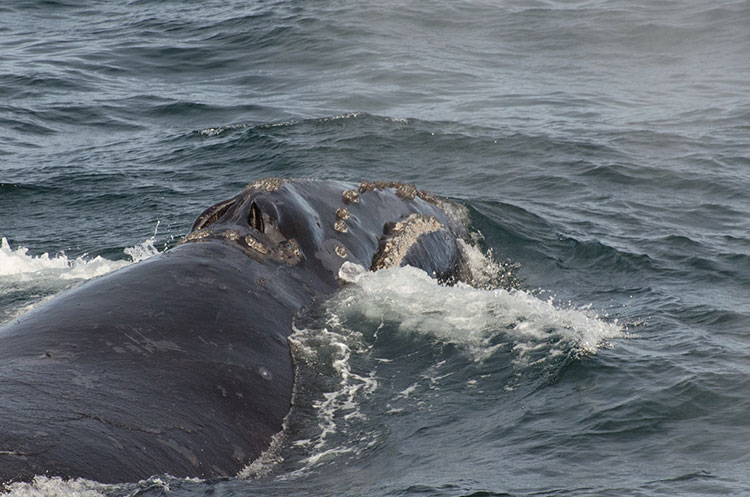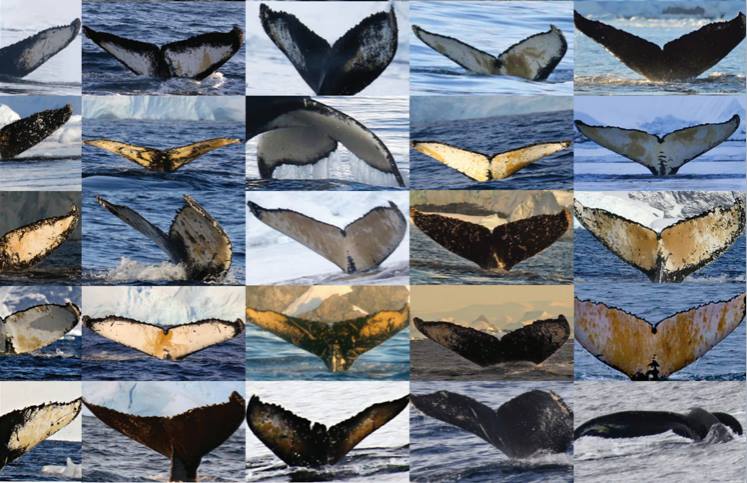2017-2018 Speaker Series
The Puget Sound Chapter of the American Cetacean Society would like to sincerely thank the following people for giving a presentation at one of our monthly Speaker Series meetings.
Click on any of the Abstract links for a summary and a brief bio about the talk Many abstracts also contain additional related resources.
Right whales in the eastern North Pacific once numbered in the tens of thousands, and were distributed throughout the Bering Sea and Gulf of Alaska. However, after becoming the target of extensive whaling, its population now numbers in the tens of animals. Unfortunately, there is still so much about this species that we do not know, including the location of their breeding grounds or migration routes. With only an estimated 30 individuals remaining, finding every individual and monitoring year-round in the remote Bering Sea is essential – but not without its challenges. This talk will focus on what is currently known about the Pacific right whale, discuss the current research being done, and highlight the struggles and rewards of studying the world's rarest whale.
Jessica is a research biologist at the Alaska Fisheries Science Center's Marine Mammal Laboratory. She joined the lab's Cetacean Assessment and Ecology Program in 2009 after completing her M.S. at the University of San Diego on killer whale vocal development. Her research at MML focuses on marine mammal passive acoustics, with an emphasis on population monitoring, spatio-temporal distribution, vocal behavior, and call characteristics of Arctic and sub-Arctic marine mammals. Jessica grew up in Phoenix, and when she's not at work, you'll usually find her snowboarding in winter or paddleboarding in summer.

North Pacific Right Whale... © 2017 IWC - photographer: Jess Taylor
18 April 2018 - Richard Huey (WSF)
Washington State Ferries: Marine Species Protection, Terminal Construction and Ferry Vessel Noise... Abstract
Richard's presentation will include information about Marine Species Protection, Terminal Construction, and Ferry Vessel Noise. The Ferry noise section focuses on in-water noise and the potential effects on marine mammals.
Richard Huey is the Senior Biologist for the Washington State Ferry System (WSF). He is the Endangered Species Act and Marine Mammal Protection Act lead for WSF, working on the analysis of underwater noise from pile driving, the protection of marine mammals during in-water construction, and on the emerging issue of ferry vessel underwater noise. Richard has participated on the Port of Vancouver ECHO Advisory Working Group, focusing on vessel noise impacts on marine mammals. His degree in Biology is from Western Washington University, and his Masters is from the University of Washington School of Marine and Environmental Affairs.
21 March 2018 - Frances Robertson
Tidal Attractions: Marine mammals and renewable energy ... Abstract
The coastal marine regions offer an excellent source of renewable energy. Tides and currents are predictable in space and time so ideal for tidal energy. Coastal areas with strong currents are also popular with marine mammals often providing good feeding opportunities. However, little is known about how marine mammals will be affected by the presence of tidal energy developments in their habitats and because marine mammals are dependent of sound to feed and navigate the impacts of introduced sound are of particular concern. To understand how marine mammals might behave in response to the noise produced by an operating tidal turbine we conducted a playback study in Admiralty Inlet at the location of the once proposed test-turbine. Over the course of the study we encountered 10 species of marine mammals but the most common species included harbor porpoise, harbor seal and Steller sea lions. The playback study provided insights into the seasonal presence and behaviors of these three species as well as allowing us to conduct one of the first studies into understanding the how tidal turbine operational noise might influence these species. The results of our study will improve both our understanding of harbor porpoise and harbor seals in Puget Sound and how these species behave in the presence of tidal turbine noise.
Frances Robertson is a wildlife biologist with over a decade of experience studying marine mammals. Her research and work centers on understanding how marine mammals interact with and respond to human activities and changes within their environment. She is currently a Post-Doctoral Fellow at Simon Fraser University and Research Scientist at SMRU Consulting North America but is soon to be the Marine Program Coordinator for San Juan County. Frances studies the impacts of human activities on marine mammals including the impacts of vessel presence, acoustic alarms, oil and gas exploration activities and renewable energy developments. In her "spare" time she studies the ecology of minke whales in the northeast Pacific and the historical whaling activities of Washington's coastal tribes.

21 February 2018 - Sally Mizroch, Blue Sea Research
The Mysterious Sei Whale ... Abstract

Sally Mizroch worked at the Alaska Fisheries Science Center in Seattle, Washington from January 1977 until she retired in May 2016, when she founded Blue Sea Research. She was a member of the U.S. delegation to the International Whaling Commission’s (IWC) Scientific Committee from 1980-1988 and has attended the past three IWC meetings as an invited participant.
In 1986, she developed the humpback whale matching system and started the centralized North Pacific humpback whale flukes photo database. She has conducted fieldwork throughout the North Pacific and she has participated in international scientific conferences throughout the world. In 2011, 2012 and 2014, she spent 2-months at sea each summer surveying remote areas of the North Pacific on a Japanese research ship as part of the Pacific Ocean Whales and Ecosystem Research (POWER) program.
In recent years, Sally (in collaboration with Dale Rice) has been writing comprehensive and complex papers on killer whales and on the distribution and movements of large whales in the North Pacific. Their papers on fin whale and sperm whales have been published and their paper on North Pacific sei whales is in final stages of revision. They also have a draft paper in progress on distribution and movements of North Pacific humpback whales.
She has used both whaling and photo-identification data to estimate vital rates of many cetacean species and populations over the course of her long career. She is particularly interested in large mammal population dynamics and reproductive biology and enjoys fostering large-scale collaborative research.
15 November 2017 - Ted Cheeseman, Cheesemans' Ecology Safaris
Understanding West Coast Humpback Whales ... Abstract
Understanding West Coast Humpback Whales — A beautiful recovery... so what now?
We've gone from whale killing to whale loving in just a generation; today’s older generations used ‘whalebone’ (baleen) where we now use plastic, and West Coast whaling stations remained operational within many of our lifetimes. Our whales began to recover, and we now enjoy the fruits of this recovery with a robust whale watching industry that is far larger worldwide than whaling ever was. But what are our whales doing and how are they managing in an increasingly industrialized ocean? Tonight’s lecture will explore the dynamics of the great whales in our marine ecosystem as learned through photographic ID and citizen science. Today thanks to automated image recognition and the citizen science website www.happywhale.com, anybody can explore the history of individual whales migrating along the west coast and around the world. Image contributors become citizen scientists, contributing to a deepening world of understanding the behavior of individual whales and the dynamics of our ocean ecosystem.
Ted Cheeseman grew up in California, son of a naturalist and zoology professor couple whose shared mission in life was to educate the public about wildlife. Ted began whale watching (and getting seasick) at a very young age and has been leading wildlife and marine mammal focused tourist expeditions for Cheesemans’ Ecology Safaris (www.cheesemans.com) for more than two decades with a focus on Antarctica and, at warmer latitudes, on responsibly operated in-water whale experiences. Ted is currently a PhD student, developer of the marine mammal citizen science platform www.happywhale.com, and director of Cheesemans’ Ecology Safaris.

18 October 2017 - Mark Leiren-Young
The Killer Whale Who Changed the World ... Abstract
Journalist, filmmaker, playwright, and author Mark Leiren-Young shares the fascinating and heartbreaking account of Moby Doll, the first publicly exhibited captive killer whale―a story that forever changed the way we see orcas and sparked the movement to save them.
Leiren-Young will share rare film footage of Moby Doll and other orcas, and discuss how the capture of Moby Doll led to the captivity and exhibition of other whales including Namu at the Seattle Aquarium and the notorious star of Blackfish, Tilicum. Moby Doll changed public perception of whales but also inspired a whole generation of scientists to learn more about how these creatures live and communicate in the wild. Because of Moby Doll, we stopped fearing "killers" and grew to love and respect "orcas."
Mark Leiren-Young is a journalist, filmmaker and author of numerous books. His article for the Walrus about Moby Doll, the first orca publicly exhibited in captivity, was a finalist for the National Magazine Award, and he won the Jack Webster award for his CBC Ideas radio documentary Moby Doll: The Whale that Changed the World. Leiren-Young is currently finishing a feature length film documentary on Moby Doll.

20 September 2017 - David and Dottie Bonnett
The Sonic World of the Amazon River Dolphin ... Abstract
David E. Bonnett will present his most recent findings of his acoustical research with Amazonian River Dolphin (Inia geoffrensis) There is a growing urgency to better understand this threatened species because of increasing anthropogenic pressures on both Inia and their habitat. This is a story that will be familiar to Citizens of the Salish Sea.
Dave Bonnett retired from his Naval Submarine service in 1979 and has subsequently worked in a variety of technology related jobs including collecting underwater sounds from marine mammals
Since 2007 David Bonnett and his wife, Dottie, have recorded the underwater sounds of Inia geoffrensis. Over their many recording trips into the Peruvian Amazon, they accumulated a large acoustic database of these dolphins' sounds. Their aim was to collect and use the "voice prints" to count these animals and establish a baseline census to study population trends.


